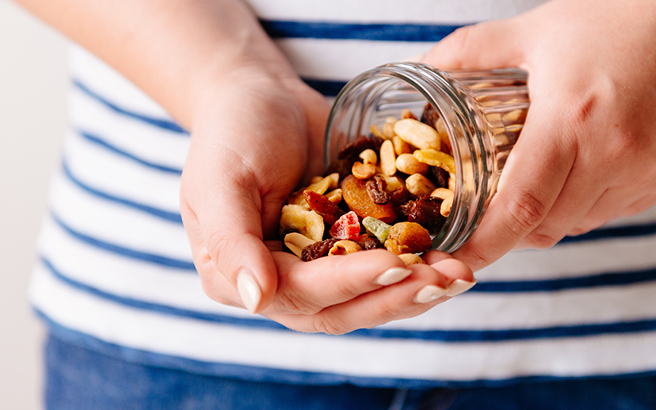 Matt Lambert, nutritionist at World Cancer Research Fund (WCRF), shares his tips for smart snacking.
Matt Lambert, nutritionist at World Cancer Research Fund (WCRF), shares his tips for smart snacking.
With most of us spending a lot of time at home due to the coronavirus (COVID-19) pandemic, and potentially with more time on our hands, we may feel tempted to snack more. But it’s important to snack sensibly – to help manage our weight, but also to help keep ourselves healthy.
The UK is one of the biggest consumers of snacks, with recent figures showing that 95% of adults are snacking. However, many of us snack on not so healthy food such as chocolate, crisps and biscuits. The downside to these types of food is that they lack in vitamins, minerals and fibre, and are often higher in saturated fat, sugar and salt. They also don’t really satisfy us, so can lead to us eating more than we normally would. This means more calories, saturated fat, sugars and salt – not great for our health or our weight!
Do we need to snack?
Snacking isn’t inherently bad for us; it’s about doing it in moderation and making healthy choices. The right type of snack can help us consume more nutrient-rich food in our diet, such as fruit and vegetables – which is important as only around one in four of us are meeting the government’s recommended 5 A DAY.
The key is to choose healthy options; those that are lower in saturated fat, sugar and salt, and higher in fibre. Smart snacking can provide you with valuable nutrients and energy, and can also help prevent overeating at main meals by stopping you getting too hungry.
Using our ideas below, you can make snacks a healthy and valuable part of your daily diet.
What are healthy snack options?
- Plain popcorn – sprinkle with some chilli powder, smoked paprika or cinnamon for a flavour boost.
- A wholemeal bagel with low-fat soft cheese.
- A slice of wholemeal toast with sliced banana and a little honey or thinly spread nut butter.
- Or try our delicious fruity oat flapjacks recipe.
Fruit and vegetable-boosting snacks
- Carrot, cucumber or celery sticks with houmous. Try our simple roasted red pepper houmous recipe.
- Homemade fruit smoothie – frozen fruit (and vegetables) are versatile, cheaper than fresh, and make a quick and nutritious snack.
- Frozen yoghurt – try our healthier strawberry frozen yoghurt recipe.
Protein-boosting snacks
Protein-rich food can help to keep us feeling fuller for longer, so are a good option if you get hungry between meals.
- Nuts and seeds – a small handful (around 30g) of unsalted nuts (like almonds, cashews or peanuts) and/or seeds (like sunflower or pumpkin seeds). Sprinkle with paprika for added flavour.
- Low-fat Greek-style yoghurt (no added sugar) topped with a tablespoon of crushed nuts or fresh fruit.
Top tips for healthy snacking
- Portion control – consider the portion size of your snack, particularly if it’s high in saturated fat, sugar and salt. You can eat larger portions of fruit and vegetables as a snack.
- Check the label – if buying pre-packaged snacks, choose those with more greens and ambers on the label, and keep an eye on the calories.
- Number of snacks – keep an eye on how many snacks you are eating during the day. Aim for two to three regular meals per day and no more than one or two snacks between your main meals.
- Keep less healthy snacks out of sight – out of sight, out of mind!
- Try to avoid buying less nutritious snacks such as crisps, biscuits and chocolate so you don’t have them tempting you while at home.



